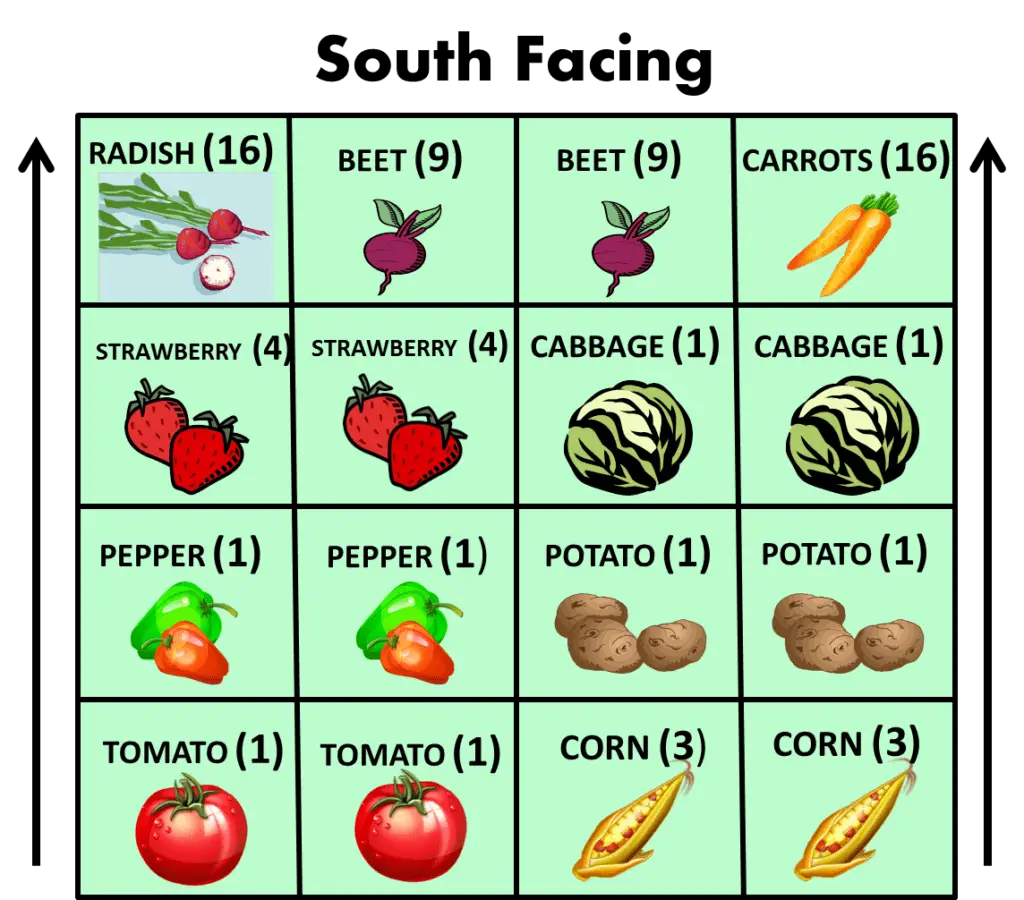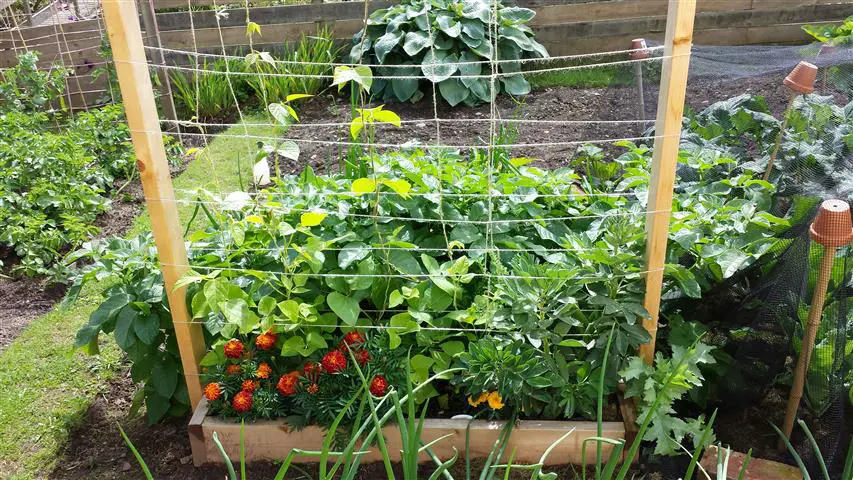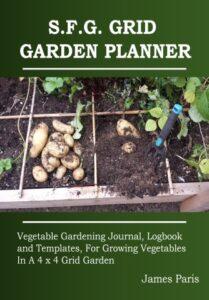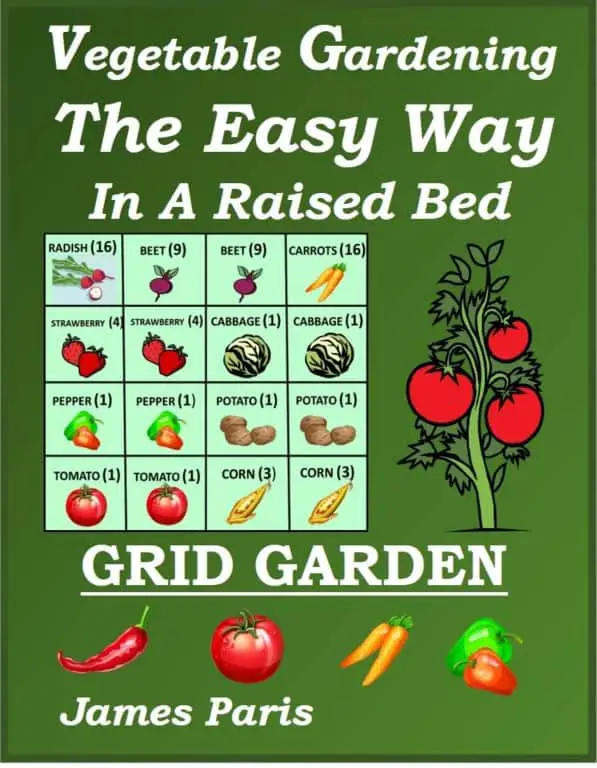There is a virtually unlimited selection of vegetables or fruit that you can grow using the Square Foot system. Even though it is traditionally practiced using a 4 x 4 foot square Raised Bed, it can be adapted to suit any size that the gardener requires.
The main criteria is that the area you choose has a grid system the separates the growing area into 12” squares or ‘grids’.

This is a type of no-dig gardening technique that is easier to maintain than the typical ‘row’ type gardening system. It is also more productive and takes up far less space that a traditional vegetable garden.
Urban dwellers and even city folks are particularly enthusiastic about growing vegetables in a Grid garden for many reasons, some of which I have listed below.
Advantages Of A Square Foot Garden
- Grow more vegetables using less space
- Easy to maintain and service
- Virtually weed-free or little weeding required
- Ideal for Companion planting
- Grow what you need when you need it with less waste.
- Easy growing method for beginners
- Easy rotational planting method that will produce a variety of vegetables throughout the season.
The SFG method also revolves around the number of plants you can grow per square foot. As this number varies according to the size and requirements of the plants involved, this chart below will give you not only the numbers involved, but also the approximate growing times of each plant to maturity.
also revolves around the number of plants you can grow per square foot. As this number varies according to the size and requirements of the plants involved, this chart below will give you not only the numbers involved, but also the approximate growing times of each plant to maturity.
To make things even easier you may use a fixed template such as this one on Amazon to sort out the number of seeds per square foot.
to sort out the number of seeds per square foot.
Square Foot Garden Planting Chart
| Plants | Approx Days to Harvest | No Per Square |
| ASPARAGUS (after shoots appear) | 14-21 | 1 |
| BASIL | 40-45 | 4 |
| BROCCOLI | 85-110 | 1 |
| BEETS | 50-70 | 9 |
| BEANS (pole) | 70-80 | 4-8 |
| BRUSSELS SPROUTS | 85-100 | 1 |
| CABBAGE | 90-100 | 1 |
| CAULIFLOWER | 85-110 | 1 |
| CARROT | 70 | 16 |
| CELERY | 60-65 | 9 |
| CORN | 80 | 3 |
| CHIVES | 80 | 16 |
| CUCUMBER | 55 | 2 |
| DILL | 65-70 | 1 |
| EGGPLANT (Aubergine) | 110-120 | 1 |
| GARLIC | 90-100 | 4 |
| LETTUCE | 40-80 | 4 |
| LEEK | 100-125 | 9 |
| MINT | 30-45 | 1 |
| ONIONS | 95-110 | 4 |
| OREGANO | 50-60 | 1 |
| PARSELY | 80-90 | 4 |
| PEAS | 70-80 | 8 |
| PEPPERS | 70-80 | 1 |
| POTATO | 80-100 | 1 |
| RADISH | 28 | 16 |
| ROSEMARY | 85 | 1 |
| SAGE | 60-90 | 1 |
| STRAWBERRY | 60-90 | 4 |
| SCALLION (Spring Onion) | 60-70 | 16 |
| SPINACH | 45-50 | 9 |
| SQUASH | 85-90 | 1 |
| TOMATOES | 70-75 | 1 |
| WATER MELON | 80-85 | 1 |
| ZUCCHINI (courgette) | 80 | 1 |
Square Foot Garden Location
Just as important as the type of vegetables and indeed the special SFG infill that is so essential to successful planting, is placing your Raised Bed garden in the right location.
Keep in mind that you are aiming for around 8 hours sunshine per day, and do not place your SFG under overhanging trees – especially pine trees which are very acidic and cast a lot of shade.
Choosing Your SFG Plants
To help you choose which vegetables you would like to grow, there are several factors you have to take into account, quite apart from the recommended numbers per square.
- Your climate: Don’t try and grow plants in a climate not suited to them. For instance tender plants can be very vulnerable to frosts, but hardier vegetables can cope with bouts of cooler weather. Sometimes you can help things along though by covering your Raised Bed SFG with a mini-greenhouse type frame.
- Growing Season: Consider the length of your growing season in comparison to the length of time to mature your crop.
- What do you like? Don’t grow what you cannot eat if possible – obvious I know but sometimes you can be tempted just by the challenge of growing something different – this usually just leads to a lot of waste though!
- Soil Quality: This of course should not be a problem if you have followed the general guide for infilling your SFG.
Also keep in mind that leafy plants such as zucchini, cabbage, cauliflower, potatoes etc, do take up a lot of space and can put less obtrusive vegetables in the shade – which is ok if they can stand a bit of shade!
Keep taller plants like peas and beans, tomato plants to the back of the bed so they do not overwhelm the smaller veggies. You can see an example of this in the following picture, where a frame has been set up to allow climbing plants to grow.
You will also see that dwarf marigold plants have been mixed in? These provide a splash of color to the arrangement and are also an excellent Companion plant as they attrcat hoverflies, whose larvae in turn feed on aphids.

Some examples of plant numbers and types can be seen in the pictures.
Popular vegetables to plant in a typical Square foot garden arrangement include the following in each square foot.
- 16 carrots
- 1 cabbage plant
- 1 potato plant
- 16 radish
- 4 strawberry plants
- 16 scallion
- 1 zucchini
- 9 leeks
- 16 chives
- 1 tomato plant
- 4 garlic
- 4 lettuce
Check out the chart above for more suggestions as per numbers per square.
Hopefully this will show you there is a huge number of vegetables you can grow in a grid garden – the choice really just depends on your climate, and of course your own taste in vegetables!
Finally, although this article has been about the vegetables you can grow in a Square Foot or Grid Garden, there is a lot to be said about the actual technique of rotational gardening and indeed the very special soil mix (see the link above) that really boosts the output and success of your SFG.
If you wish to know more about the SFG method then check out this article for more info.
Links throughout this post will take you to other aspects of the Grid Gardening technique, as indeed will the Grid Gardening book available on Amazon in Paperback and digital versions.
available on Amazon in Paperback and digital versions.




